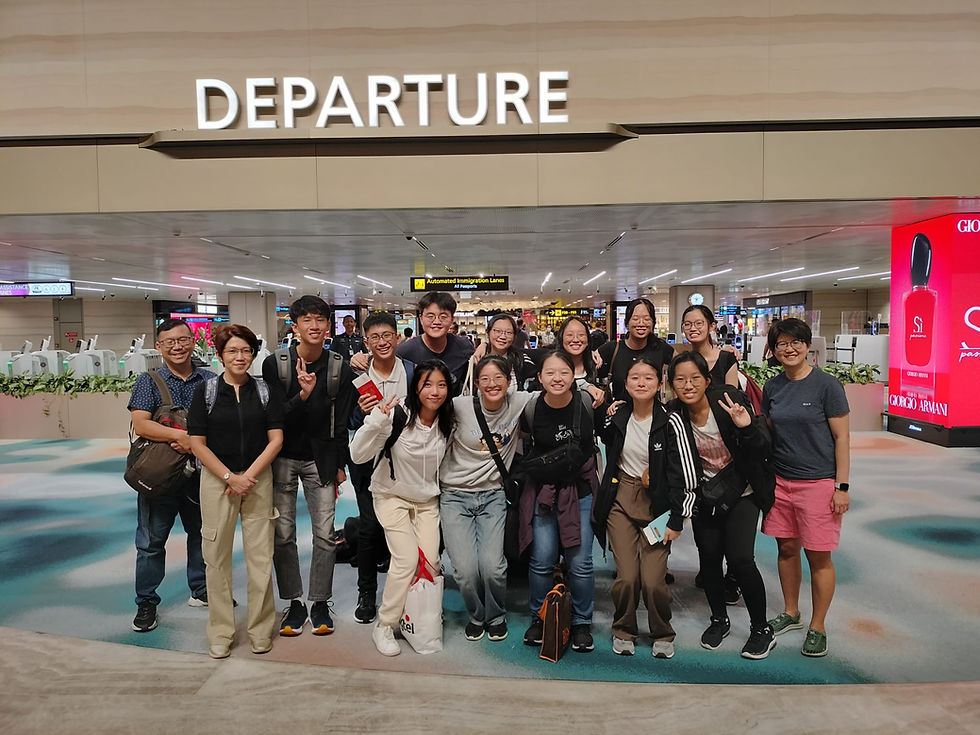

River Valley Student Editorial Club
Aug 241 min read

For RVians, by RVians



Chua Wen Zhe (23J20)
From 23rd May to 2nd June, blessed with the easing of COVID restrictions, the Humanities and Social Sciences Leaders Academy (HSSLA) resumed our yearly Overseas Expedition Learning Programme (OELP). This year, twelve HSSLA members had the wondrous opportunity to venture to Belfast, Dublin, and London.

📍At Changi Airport, Departing for Belfast!
The 10-day trip was packed to the brim with visits to various significant locations, with lots of learning and takeaways. With the care of Mr William Wee, Ms Candida Ho and our tour manager, Mr Ayoub, we explored the political scene of Northern Ireland, went down to Dublin, and ended our trip at the great economic hub, London.

At Carrick-A-Rede!
Living in the tiny city-state of Singapore means that much of the great geographical landforms that we learn about during Geography remain theoretical constructs in our textbooks. As quipped by Tay Yu Xuan (23J07), experiencing the coastal landforms at Carrick-A-Rede and the Giant’s Causeway first-hand was really eye-opening. To see the destructive waves that over time resulted in the erosion of the cliffs at Carrick-A-Rede, forming majestic caves, arches and stumps, was indeed something to treasure as it is sadly not easily accessible. 🙁
Well, maybe it is good that in Singapore our coastline does not get eroded or our already-small island will become even smaller over time!
Have a look at the majestic view!

Hey students, look! The ocean’s so vast, just like the possibilities in your life. Start exploring the uncharted waters!

Ruminating about existence

Look at this beauty! Right out of our exam papers
Did you know that Game of Thrones was filmed in Ireland? It was due to the accessibility of the fascinating Irish landscape which likewise inspired many writers and painters!

One of the Game of Thrones doors!
No doubt, the day spent in the coastal regions of Northern Ireland was something that the Geography students enjoyed a lot, especially Neo Rui Ern, Vanessa (22J02) who could not resist the opportunity to ‘gift’ Ms Ho a geological specimen picked up at the Giant’s Causeway, reminding her that she rocks 😂

At Giant’s Causeway!

Learning about the Troubles at Derry/Londonderry!
To clear any misunderstandings, Northern Ireland is part of the United Kingdom, while the Republic of Ireland is not. To put it simply, they were both at some point in history part of the United Kingdom, but due to Protestants in Northern Ireland wanting to be part of the United Kingdom, while the Catholic majority in the South sought independence, a chain of events ensued and the Republic of Ireland was created in 1949 while Northern Ireland remains a territory of the United Kingdom.
However, even within Northern Ireland, the divide between the Protestants (whom we often refer to as ‘Christians’ in Singapore, although technically the term ‘Christians’ comprises both Protestants and Catholics) and Catholics led to bloody conflicts between the two groups, especially from 1968 to 1998 which was termed The Troubles. Whilst it has ended, the divide was still apparent as we went about in Northern Ireland with expressions of loyalty such as the Irish flags and Union Jacks (UK’s flag) that abound – covertly mounted on lamp posts by residents, or put up on shopfronts. We even saw curbs painted with red and blue paint. These markers showed us whether an area was largely Loyalist (Protestants wanting to be part of the UK, also known as the Unionists) or Republicans (Catholics wanting to be part of the Republic of Ireland, also known as Nationalists).
Take a look at these political markers!



Also, we visited the Peace Wall, a series of walls used to separate the Catholics and the Protestants, especially during The Troubles, when violence was experienced by people living in each Catholic or Protestant-dominated district. All of these are strong reminders to us of the devastating consequences of a religious divide, something that multi-racial, multi-religious Singapore has done well in avoiding. Unfortunately, this divide, owing to its complicated and long history of reprisals and revenge, continues to exist as an undercurrent of social tension in the consciousness of people living in Northern Ireland.
Moving on to something that we rarely see in neat and orderly Singapore: The abundance of murals and graffiti, often political, in Belfast, Dublin, and London.
Many in Singapore might view these visual expressions as vandalism, which I do agree with as they are infringements on private and public property. However, many of them are rather artistically pleasing and the passion in the messages is evident, and even moving at times, with many being politically charged with cries of injustice. Here are the photos of some of them for you to have a look at and appreciate.


The Political Murals and Graffiti, something that Singapore does not have
Moving on to another phenomenon we saw during our trip: the diaspora. This refers to the dispersion or spread of a people from their original homeland. During our trip, we met several people who had moved to the UK and Ireland from their countries of origin.
Whilst enjoying the scrumptious Chinese food at Red Panda Restaurant (the tour agency feared we would greatly miss our local Singaporean food 😂), Wong Zi Tian (22J08) had quite a banter with the service staff, owing to their common Malaysian background! We learned that the waiter was a university student at Belfast, and was working part-time during his holidays. He mentioned that he decided to go overseas to further his studies for better career opportunities and to pursue a different way of life.
Also, while touring University College Dublin, we found that our student guide was from Romania!

At University College Dublin!
However, one of the chilling reminders of the trip was that a diaspora often occurs due to push factors, which marked the Irish Diaspora, where the majority of Irish, or people of Irish descent, are not living in Ireland but have moved overseas. This is in part due to the potato famine in the 19th century, when a tragically massive blight destroyed most of Ireland’s potato crop – a fundamental component of the Irish diet as well as their livestock. As such, famine drove many to seek a better life overseas in countries like the USA and the rest of Europe. One notable member of the Irish Diaspora is the current US President Joe Biden, who proudly admits his Irish heritage!
*Fun fact: Former US President Barack Obama’s seventh great-grandfather was Irish!
As the world has become more interconnected than ever, many Irish have continued to venture overseas not because they have to, but because they want to, to seek opportunities for studies or work.
Dublin is one of the UNESCO Cities of Literature. There, we had the opportunity to visit a museum dedicated to renowned writer James Joyce – the James Joyce Centre – and also write some poems!
We were wowed when we learned more about James Joyce and his magnum opus, Ulysses. Yee Ting Wei (23J08) recounted how he was very much inspired by the ingenuity of James Joyce in creating new words with abandon, and how the writing of Ulysses could be plotted on a map of the digestive system. For me, as I love cats (when looking at them from afar), I’m really impressed by how he invented a new word to more accurately describe the sound of a cat meow-ing, which is ‘mrkgnao’! Try reading it aloud!

Mrkgnao!
Indeed, James Joyce is a very experimental writer, and Ulysses is a great literary text, albeit hard to read and digest due to its sheer complexity and even unwieldy due to the sheer number of pages. Chai Yu Han (22J08) did share a ‘hack’ that she has with us: Through Apple Books, we can read a free e-copy of Ulysses, with which she managed to successfully complete the first few chapters by the start of the trip.
At the suggestion of Ms Ho, after our lovely visit to the National Gallery of Dublin, we emulated literary intellectuals and wrote poems while enjoying the sun, sitting on the grass in a park nearby. I for sure finally understood why writers often write about people relaxing and lazing on the grass, for the grassy surface in summer proved to be the perfect carpet to rest upon! Back to our purpose of ‘parking’ ourselves on the verdant turf, we wrote ekphrastic poems – poetry that responded to artwork we loved at the gallery.

Enjoying life and writing poems in Dublin
Liu Xuanyi (23J19) recounts how she was initially daunted by the prospect of writing a poem, but as time went by she found it easier to express her thoughts through verse. Here’s her poem, and another by Spring Ashleigh Lin Yiting (22J20)!
Xuanyi and Spring’s poems!
P.S. There is a bonus poem in the next part of this article, so keep a lookout for the next post to view it!


Comments